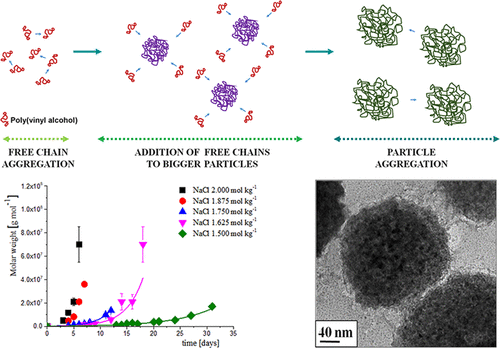当前位置:
X-MOL 学术
›
Macromolecules
›
论文详情
Our official English website, www.x-mol.net, welcomes your
feedback! (Note: you will need to create a separate account there.)
Revealing the Aggregation Mechanism, Structure, and Internal Dynamics of Poly(vinyl alcohol) Microgel Prepared through Liquid–Liquid Phase Separation
Macromolecules ( IF 5.1 ) Pub Date : 2020-01-21 , DOI: 10.1021/acs.macromol.9b02203 Marco Perfetti 1, 2 , Noemi Gallucci 1, 2 , Irene Russo Krauss 1, 2 , Aurel Radulescu 3 , Stefano Pasini 3 , Olaf Holderer 3 , Gerardino D’Errico 1, 2 , Giuseppe Vitiello 2, 4 , Giulia Ottavia Bianchetti 5 , Luigi Paduano 1, 2
Macromolecules ( IF 5.1 ) Pub Date : 2020-01-21 , DOI: 10.1021/acs.macromol.9b02203 Marco Perfetti 1, 2 , Noemi Gallucci 1, 2 , Irene Russo Krauss 1, 2 , Aurel Radulescu 3 , Stefano Pasini 3 , Olaf Holderer 3 , Gerardino D’Errico 1, 2 , Giuseppe Vitiello 2, 4 , Giulia Ottavia Bianchetti 5 , Luigi Paduano 1, 2
Affiliation

|
The use of technologies based on soft polymer particles represents an effective way to deliver target molecules with a specific function. To design a well-performing delivery system, it is fundamental to rationalize both the aggregation and the structural properties of such particles. In this study, we present the kinetic and structural characterization over time of poly(vinyl alcohol) (PVA) microgels obtained through a salting-out process in the presence of NaCl. We have analyzed how both the polymer and salt concentrations affect the aggregation process. The aggregation rate as well as the morphology and physico-chemical parameters, such as mass and chain density of the microgels, have been determined through static and dynamic light scattering and discussed in the framework of the diffusion-limited and reaction-limited colloid aggregation. Insights into the polymer chain arrangements and their dynamics have been gained by means of small-angle neutron scattering and neutron spin-echo measurements. As a result, it was found that NaCl induces a liquid phase separation in solution with the formation of spherical PVA microaggregates, which grow under a reaction-limited aggregation mechanism. The particles increase their size and compactness over time. Within the aggregate, the polymer chains are locally organized to form randomly oriented lamellae with a thickness of about 60 Å. The internal dynamics is a complex mixture of diffusion, Zimm dynamics, and possibly effects from crowding with the transition to a Rouse-like behavior. The microparticle preparation based on the salting-out process constitutes a novelty, if compared to the methods already existing and based on the use of chemical cross-linkers, and is a cheap and easy protocol that allows tuning both particle size and density by varying the salt concentration.
中文翻译:

揭示通过液-液相分离制备的聚乙烯醇微凝胶的聚集机理,结构和内部动力学
基于软聚合物颗粒的技术的使用代表了一种传递具有特定功能的目标分子的有效方法。为了设计出性能良好的输送系统,合理化此类颗粒的聚集和结构特性是至关重要的。在这项研究中,我们介绍了在NaCl存在下通过盐析过程获得的聚乙烯醇(PVA)微凝胶随时间变化的动力学和结构特征。我们已经分析了聚合物和盐浓度如何影响聚集过程。已经通过静态和动态光散射确定了聚集速率以及微凝胶的形态和理化参数,例如质量和链密度,并在扩散受限和反应受限的胶体聚集的框架中进行了讨论。通过小角度中子散射和中子自旋回波测量,已经获得了对聚合物链排列及其动力学的见解。结果,发现NaCl在溶液中诱导液相分离,形成球形PVA微聚集体,其在反应受限的聚集机制下生长。随着时间的流逝,颗粒会增加其尺寸和紧密度。在骨料中,聚合物链局部组织形成厚度约60的无规取向片。内部动力学是扩散,Zimm动力学以及可能过渡到类似于Rouse行为的拥挤效应的复杂混合物。基于盐析过程的微粒制剂具有新颖性,
更新日期:2020-01-22
中文翻译:

揭示通过液-液相分离制备的聚乙烯醇微凝胶的聚集机理,结构和内部动力学
基于软聚合物颗粒的技术的使用代表了一种传递具有特定功能的目标分子的有效方法。为了设计出性能良好的输送系统,合理化此类颗粒的聚集和结构特性是至关重要的。在这项研究中,我们介绍了在NaCl存在下通过盐析过程获得的聚乙烯醇(PVA)微凝胶随时间变化的动力学和结构特征。我们已经分析了聚合物和盐浓度如何影响聚集过程。已经通过静态和动态光散射确定了聚集速率以及微凝胶的形态和理化参数,例如质量和链密度,并在扩散受限和反应受限的胶体聚集的框架中进行了讨论。通过小角度中子散射和中子自旋回波测量,已经获得了对聚合物链排列及其动力学的见解。结果,发现NaCl在溶液中诱导液相分离,形成球形PVA微聚集体,其在反应受限的聚集机制下生长。随着时间的流逝,颗粒会增加其尺寸和紧密度。在骨料中,聚合物链局部组织形成厚度约60的无规取向片。内部动力学是扩散,Zimm动力学以及可能过渡到类似于Rouse行为的拥挤效应的复杂混合物。基于盐析过程的微粒制剂具有新颖性,









































 京公网安备 11010802027423号
京公网安备 11010802027423号